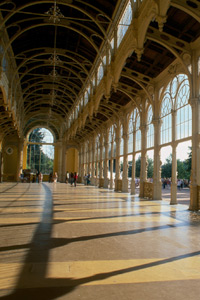The Czech Republic has a number of mineral springs, which have been used for medicinal purposes since the early 15th century. Spa towns with specific spa architecture and grand urban conceptions grew up around mineral springs. The colonnades of Karlovy Vary and the splendid spa buildings in Mariánské Lázne are world-famous. Czech spa towns are invariably located in natural landscapes and are attractive for both their urbanistic layout and their specific spa architecture. Some spa houses even boast elaborate original furnishings.
Large spa houses started to be built along with colonnades and decorative structures above and around mineral springs. Spa towns began adopting a systematic approach to their architectural planning and strove for a unified appearance. Much attention was devoted to the mineral springs themselves, with geological probes and chemical analyses of the waters’ contents; this was a very dynamic era. Tough competition became the hallmark of the spa industry, and local spa entrepreneurs thrived.
Czech spas were frequented by a highly sophisticated clientele. To this day, the spa towns of Karlovy Vary and Teplice pride themselves on the visits by Peter the Great, King Edward VII of England and Albrecht of Wallenstein. Frequent spa guests also included such giants of European culture as Goethe, Schiller, Chopin, Beethoven and Wagner, to name just a few.
The 18th century was the period of birth and development of the spa industry; but it was the 19th century in which spas truly began to flourish. Spa complexes were expanded and modernised; a number of new treatment methods were introduced. Spa procedures became specialised, and the Czech spa industry became renowned for its medical efficiency. Spa stays were no longer considered just a form of treatment; they became a hallmark of social status. Spa towns have developed into centres of social and cultural life and magnets for tourism. After Prague, they were the second most visited destination in the country.
The last decade of the past century opened up new horizons to Czech spas. Lifestyle changes dictated the expansion of spa programs to include new forms of relaxation and regeneration, beauty treatments and stress-reduction programs. These are all complemented by a range of sports and fitness activities such as golf, cycling, hiking and walking, tennis, gym routines and other activities. Expanded spa programs are offered by no fewer than 40 spa towns in the Czech Republic.
Trebon
The town of Trebon is situated on the hilly landscape of South Bohemia. The well-preserved historic town centre became a conservation area. The spa, the Renaissance chateau with attached parks and the large artificial lake, Svet, create an attractive complex with unique diversity. Deep forests and a number of colourful artificial lakes add up to a beautiful landscape. The whole region is a protected area and a biosphere reserve of UNESCO. The landscape has been cultivated for centuries from the original swamps and peat bogs. The Trebon area is also the traditional area for fish farming, mainly the famous Trebon carps.
There are many facilities and activities available including, swimming pools, gymnasiums, fitness facilities, solariums, tennis courts, horseback riding, fishing, water sports, cyclist routes and sports equipment, mountain bike and boat rentals. Observation sailing is possible on the Svet and Hejtman lakes.
Jeseník
Jeseník is situated in the Olomouc region. It became famous for gold mining and the production of damask, as well as its Silesian marble. But it has become even better known for its spas. In 1820, Vincent Priessnitz founded the Jeseník spas. He discovered the healing effects of the local cold springs. The health resort specializes in the treatment of respiratory diseases and disorders of the motor and nervous systems. On the slopes of Studnicní vrch near the spa complex, there are 60 curative springs. The proximity of the Jeseníky Mountains offers an ideal way to relax either in winter or in summer.
The microclimate, combined with water treatments are suitable for respiratory diseases, circulation disorders, thyroid diseases, physical and gynecological disorders and skin diseases.
Tennis, mini-golf, squash, bowling, horseback riding, indoor swimming pool, sauna, sports equipment rentals, fitness programs, skating, skiing are all available.
Podebrady
In the 15th century, King George raised the status of the town of Podebrady to that of royal town. In the 17th century, a small spa was built on the site of one healing spring. The recent history of the town and spas had its beginning in the Art Nouveau period, when another strong mineral spring was discovered. The spring contains a lot of carbonic acid, magnesium and calcium. The spa centre is hidden in the green of the parks. The flat area near the Labe River that is surrounded by forests is ideal for the treatment of heart diseases. The town is also famous for the production of crystal plumbic glass. The romantic environment is suitable for relaxation as well as active tourism.
The natural healing source is mineral carbonic water. The spa specialises in the treatment o heart disease, diabetes, and disorders of the motor system.
Activities available in the town include tennis, golf, mini-golf, swimming, surfing, yachting, fishing, volleyball, squash, bowling, horseback riding, cycling, special fitness programs and sailing trips on the Labe.
Podebrady mineral water was discovered with the use of a stick in 1905 by the famous water-diviner, the Prussian nobleman Büllow. In 1926, the remarkable spa guru Dr. Libenský, founded the Cardiology Institute in Podebrady and initiated the tradition of “heart spas” that implemented carbonic baths and strict medical care.





